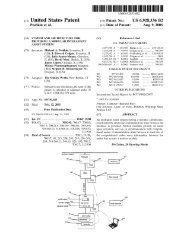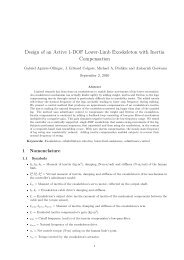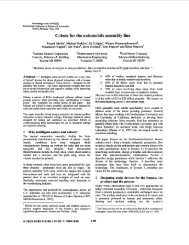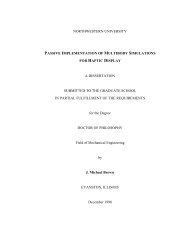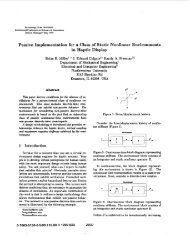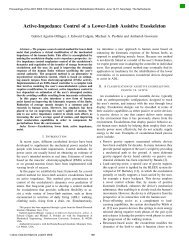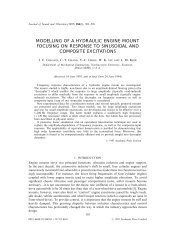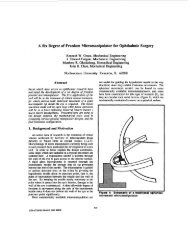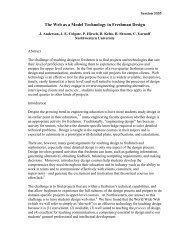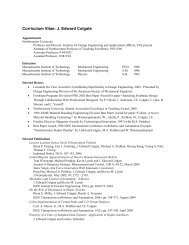Application characteristics of permanent magnet ... - Colgate
Application characteristics of permanent magnet ... - Colgate
Application characteristics of permanent magnet ... - Colgate
Create successful ePaper yourself
Turn your PDF publications into a flip-book with our unique Google optimized e-Paper software.
PILLAY AND KRISHNAN: APPLICATION CHARACTERISTICS OF dc MOTORS FOR SERVO DRIVES 987<br />
DC BRUSH<br />
APPLICATION<br />
AC MOTORS<br />
BRUSHLESS<br />
i+7<br />
PERMANENT MAGNET INDUCTION<br />
PMSM<br />
f-11<br />
SWITCHED RELUCTANCE<br />
BDCM<br />
Fig. 1. Motor selection procedure.<br />
decision to make is whether to use an ac or a switched<br />
reluctance motor. The switched reluctance motor is inherently<br />
a pulsating torque machine, although some work has<br />
been done in an attempt to reduce the torque ripple. Hence, if<br />
a reasonably smooth output torque is required, an induction<br />
or <strong>permanent</strong> <strong>magnet</strong> machine is to be preferred over the<br />
switched reluctance motor. The next decision to be made,<br />
then, is whether to use an induction or a PM motor.<br />
The <strong>permanent</strong> <strong>magnet</strong> motor drives have the following<br />
advantages over the induction motor (IM) drive [1]-[lo]:<br />
The rare earth and neodymium boron PM machine has<br />
a lower inertia when compared with an IM because <strong>of</strong><br />
the absence <strong>of</strong> a rotor cage; this makes for a faster<br />
response for a given electric torque. In other words,<br />
the torque to inertia ratio <strong>of</strong> these PM machines is<br />
higher.<br />
The PM machine has a higher efficiency than an<br />
induction machine. This is primarily because there are<br />
negligible rotor losses in <strong>permanent</strong> <strong>magnet</strong> machines;<br />
the rotor losses in the IM, however, can be considerable,<br />
depending on the operating slip. This discussion<br />
is applicable to constant flux operation.<br />
The IM requires a source <strong>of</strong> <strong>magnet</strong>izing current for<br />
excitation. The PM machine already has the excitation<br />
in the form <strong>of</strong> the rotor <strong>magnet</strong>.<br />
The need for <strong>magnet</strong>izing current and the fact that the<br />
IM has a lower efficiency necessitates a larger rated<br />
rectifier and inverter for the IM than for a PM machine<br />
<strong>of</strong> the same output capacity.<br />
The PM machine is smaller in size than an induction<br />
motor <strong>of</strong> the same capacity. Hence, it is advantageous<br />
to use PM machines, especially where space is a<br />
serious limitation. In addition, the <strong>permanent</strong> <strong>magnet</strong><br />
machine weight less. In other words, the power density<br />
<strong>of</strong> <strong>permanent</strong> <strong>magnet</strong> machines is higher.<br />
The rotor losses in a PM machine are negligible<br />
compared with those in the induction motor. A problem<br />
that has been encountered in the machine tools<br />
industry is the transferal <strong>of</strong> these rotor losses in the<br />
form <strong>of</strong> heat to the machine tools and work pieces,<br />
thus affecting the machining operation. This problem<br />
is avoided in <strong>permanent</strong> <strong>magnet</strong> machines.<br />
The induction motor drive has the following advantages<br />
over <strong>permanent</strong> <strong>magnet</strong> motor drives [2]:<br />
Larger field weakening range and ease <strong>of</strong> control in<br />
that region<br />
lower cogging torques<br />
less expensive feedback transducers such as an incremental<br />
rotor position encoder for the IM instead <strong>of</strong> an<br />
absolute position encoder that is required by the <strong>permanent</strong><br />
<strong>magnet</strong> motor drives<br />
lower cost<br />
much higher rotor operating temperatures that are<br />
allowed in induction motors than in PM motors.<br />
Depending on the application, a choice is made between an<br />
IM or ac PM motor drive if the dc brush and switched<br />
reluctance servos are excluded. If the choice is narrowed to<br />
an ac <strong>permanent</strong> <strong>magnet</strong> motor drive, then there are hardly<br />
any guidelines to differentiate the available <strong>permanent</strong> <strong>magnet</strong><br />
motor drives, namely, the PMSM drive and the BDCM<br />
drive. This paper concerns itself mainly with this aspect <strong>of</strong><br />
the problem.<br />
The paper is organized as follows: The similarities and<br />
differences between the PMSM and BDCM and the drive<br />
strategy are discussed in Section 11. Power density, torque to<br />
inertia ratio, speed range, torque per unit current, braking,<br />
parameter sensitivity, and other criteria are used to compare<br />
and contrast the PM motor drives in Section 111. Conclusions<br />
are given in Section IV.<br />
11. DESCRIPTION OF THE PMSM AND BDCM<br />
Similarities Between the PMSM and BDCM<br />
The PMSM owes its origin to the replacement <strong>of</strong> the<br />
exciter <strong>of</strong> the wound rotor synchronous machine, which<br />
included a field coil, brushes, and slip rings with a <strong>permanent</strong><br />
<strong>magnet</strong>. A distinguishing feature <strong>of</strong> the PMSM is that it<br />
generates a sinusoidal back emf just like an induction motor<br />
or wound rotor synchronous motor; in fact, the stator <strong>of</strong> the<br />
PMSM is quite similar to that <strong>of</strong> the induction machine.<br />
The BDCM owes its origin to an attempt to invert the<br />
brush dc machine to remove the need for the commutator and<br />
brush gear. The commutator in the brush dc machine converts<br />
the input dc current into approximately rectangular<br />
shaped currents <strong>of</strong> variable frequency. By applying this rectangular-shaped<br />
current directly to the stator <strong>of</strong> the BDCM<br />
and transferring the field excitation to the rotor in the form <strong>of</strong><br />
a <strong>permanent</strong> <strong>magnet</strong>, an inversion <strong>of</strong> the brush dc machine<br />
has taken place with the advantage that the new inverted<br />
machine does not have a mechanical commutator and brush<br />
gear, hen& the name brushless dc machine.<br />
The <strong>magnet</strong>s in the PMSM or the BDCM can be either<br />
buried or surface mounted. In the surface-mounted machine,<br />
two variations can exist. The <strong>magnet</strong>s can be inset into the<br />
rotor or project from the surface <strong>of</strong> the rotor. These machines<br />
will be referred to as buried, inset, and projecting PM<br />
machines, respectively.<br />
Buried PM machines are more difficult to construct than<br />
either the inset or projecting surface-mounted machines. In




